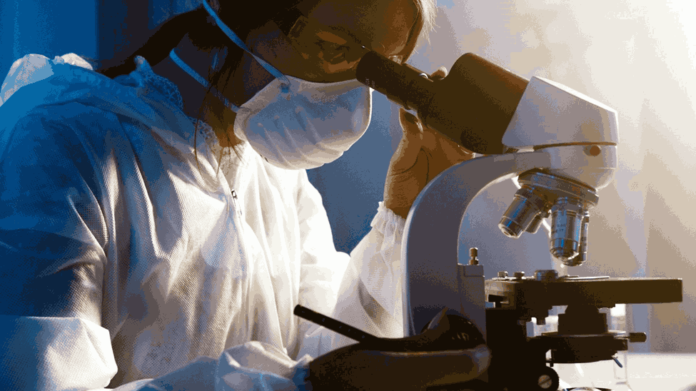SEMs are capable of analyzing just about everything, from biological specimens to semiconductors. That being said, some materials are harder to examine than others because of their non-conductive nature. To ensure you get high quality images, you need to use a good sputter coater on these samples.
How does sputter coating work for SEM, you might be asking? You’re here to find out! Below is a simple guide that will bring you up to speed on some sputter coating basics.
How Sputter Coating Works for SEM
Sputter coating is simply the process of applying an ultra-thin layer of electrically conductive metal on a non-conducting (or poorly conducting) sample. Taking place in a vacuum chamber containing an inert gas (usually argon), the specimen is placed on the anode, while the metal is placed on the cathode. High tension will then be applied to the cathode, causing argon gas to pass through the metal and eject its atoms. The loose metal atoms will then be attracted by the anode until it eventually covers the sample on top of it. Metals typically used include:
- Aluminum
- Chromium
- Gold
- Iridium
- Palladium
- Platinum
- Silver
- Tungsten
Sputter coating helps prevent the specimens from being charged (more on this below) while they are examined. More importantly, it helps the SEM detect more secondary electrons from the surface of the samplings. This basically increases the SEM’s signal to noise ratio, enabling it to produce better images. Other benefits of sputter coating for SEM include:
- Increased protection for beam sensitive specimens
- Minimal heat transfer to the sample
- Easy to operate and set up
- Great variation of applicable metals
Samples That Need Sputter Coating
2 key causes of why you need to execute sputter coating on a sample material. First, because it has little to no conductivity. And second, because it is sensitive to the SEM’s beams. Let’s delve into this further below:
Non-Conductive Samples
Non-conductive materials act pretty much like electron traps, gathering any electrons passing through it on their surface. This phenomenon is known as charging, and it’s responsible for the white regions that sometimes appear in SEM images.
Through sputter coating, you’ll be able to remove these white spots from your SEM images, giving you better representations of the specimens. The coating does so by acting as another electron trap. Only this time, it gathers the electrons and discharges it safely from the sample being examined. This results in images with better quality and resolution.
Additionally, the sputter coat’s high conductivity allows it to improve the SEM’s signal-to-noise ratio. As mentioned above, this enables the microscope to detect more secondary electrons from the surface of the samplings, thus allowing it to further produce sharper images.
Beam-Sensitive Samples
On the other hand, beam-sensitive materials refer to samples that can easily be damaged by the SEM’s electron beams. These range from biological specimens to polymer-based samplings.
Examined without any coating, the SEM’s beams will end up damaging these samples during imaging. This will result in poor-quality images, not to mention a ruined specimen (which could prove detrimental to your experiments if you have a limited supply).
By applying sputter coating on the samples beforehand, you’ll be able to examine and photograph them more safely. Think of the coating as like a mirror, whenever beams of light pass through it, it simply deflects it in a different direction. In the same way sputter coating can redirect any electron beams that go through it, thus keeping your specimens intact.
Downsides of Sputter Coating
While sputter coating can bring numerous benefits to SEM operators, it’s not without its downsides. So before trying out this preparation technique, best know the risks it entails first. These include:
Additional Time and Effort
Even if the sputter vacuum chamber is easy to set up and operate (assuming you have one in your lab in the first place), the entire sputter coating process will still take a bit of time and effort to finish. This will end up prolonging your working hours depending on how many specimens you need to coat before analyzing them.
Moreover, if you don’t have your own vacuum chamber, you’ll have to do the coating from a laboratory that does. This will take even more time and effort (not to mention money), as you’ll have to travel from your laboratory to another just to have your samples sputter coated. To top it off, you run the risk of ruining your specimens along the way.
Lost or Compromised Atomic Information
But more importantly, sputter coating increases the chances of the samples’ atomic information getting lost or compromised. Ironically, this is caused by the sputter coat itself, as it somewhat acts as a barrier that prevents the SEM from properly analyzing the specimens’ surfaces.
Luckily, there are a plethora of ways to keep away from this issue. First, SEM operators can adjust the topography of the specimen’s surface. This will help them avoid collecting incorrect atomic information. Second, you can regulate the sputter coating’s parameters (i.e., how thick the layer is, etc) to ensure you get accurate atomic numbers and what-not.
Final Thoughts
Sputter coating is a great preparation technique if you want to capture high-quality images of non-conductive and beam-sensitive samples using your SEM. but to properly harness its full potential, you need to learn as much as you can about its processes. So start with the guide above, and keep learning!
Apart from this, if you want to know about Get Sculptra Treatment for Your Cheeks then please visit our Health category







